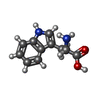+Search query
-Structure paper
| Title | Structural mechanism of cooperative activation of the human calcium-sensing receptor by Ca ions and L-tryptophan. |
|---|---|
| Journal, issue, pages | Cell Res, Vol. 31, Issue 4, Page 383-394, Year 2021 |
| Publish date | Feb 18, 2021 |
 Authors Authors | Shenglong Ling / Pan Shi / Sanling Liu / Xianyu Meng / Yingxin Zhou / Wenjing Sun / Shenghai Chang / Xing Zhang / Longhua Zhang / Chaowei Shi / Demeng Sun / Lei Liu / Changlin Tian /  |
| PubMed Abstract | The human calcium-sensing receptor (CaSR) is a class C G protein-coupled receptor (GPCR) responsible for maintaining Ca homeostasis in the blood. The general consensus is that extracellular Ca is ...The human calcium-sensing receptor (CaSR) is a class C G protein-coupled receptor (GPCR) responsible for maintaining Ca homeostasis in the blood. The general consensus is that extracellular Ca is the principal agonist of CaSR. Aliphatic and aromatic L-amino acids, such as L-Phe and L-Trp, increase the sensitivity of CaSR towards Ca and are considered allosteric activators. Crystal structures of the extracellular domain (ECD) of CaSR dimer have demonstrated Ca and L-Trp binding sites and conformational changes of the ECD upon Ca/L-Trp binding. However, it remains to be understood at the structural level how Ca/L-Trp binding to the ECD leads to conformational changes in transmembrane domains (TMDs) and consequent CaSR activation. Here, we determined the structures of full-length human CaSR in the inactive state, Ca- or L-Trp-bound states, and Ca/L-Trp-bound active state using single-particle cryo-electron microscopy. Structural studies demonstrate that L-Trp binding induces the closure of the Venus flytrap (VFT) domain of CaSR, bringing the receptor into an intermediate active state. Ca binding relays the conformational changes from the VFT domains to the TMDs, consequently inducing close contact between the two TMDs of dimeric CaSR, activating the receptor. Importantly, our structural and functional studies reveal that Ca ions and L-Trp activate CaSR cooperatively. Amino acids are not able to activate CaSR alone, but can promote the receptor activation in the presence of Ca. Our data provide complementary insights into the activation of class C GPCRs and may aid in the development of novel drugs targeting CaSR. |
 External links External links |  Cell Res / Cell Res /  PubMed:33603117 / PubMed:33603117 /  PubMed Central PubMed Central |
| Methods | EM (single particle) |
| Resolution | 3.5 - 6.8 Å |
| Structure data | EMDB-30853, PDB-7dtt: EMDB-30854, PDB-7dtu: EMDB-30855, PDB-7dtv: EMDB-30856, PDB-7dtw:  EMDB-30857:  EMDB-30858: |
| Chemicals |  ChemComp-CA:  ChemComp-NAG:  ChemComp-TRP: |
| Source |
|
 Keywords Keywords | MEMBRANE PROTEIN / GPCR / class C / calcium sensing receptor |
 Movie
Movie Controller
Controller Structure viewers
Structure viewers About Yorodumi Papers
About Yorodumi Papers











 homo sapiens (human)
homo sapiens (human)